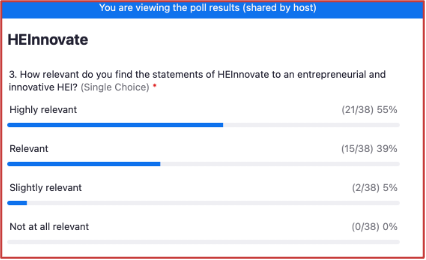HEInnovate webinar summary – New directions: sustainability, regional innovation and labour market relevance
This month’s webinar provided an opportunity to explore the user community’s views about potential adjustments of HEInnovate, so that the self-assessment tool continues to be relevant and useful for its main users, higher education institutions (HEIs).
The webinar was moderated by Rebecca Allinson, Managing Partner at Technopolis Group. It attracted an international audience of 81 who contributed to the panel discussion by providing feedback through polls completed, questions raised, and comments shared on the use and further enhancement of HEInnovate. Preceding the discussion, panellists gave presentations on a selection of ongoing initiatives which explore the role HEIs can play in addressing complex challenges, such as labour market relevance, regional innovation and sustainability.
Labour Market Relevance and the Outcomes of HE (LMRO) Partnership Initiative
Monika Wyman, European Commission, DG EAC and Andrea-Rosalinde Hofer (OECD) presented Labour Market Relevance and the Outcomes of HE (LMRO). The LMRO Partnership Initiative of the European Commission and the OECD started in 2019 with the participation of four countries: Austria, Hungary, Portugal and Slovenia. The fast pace and uncertain nature of labour market changes also present challenges for higher education institutions: they must anticipate novel jobs and skill needs, create study programmes that are relevant to these labour market needs, and rethink how to communicate with learners about future careers and with employers about graduate skills. Governments, for their part, face the need to re-examine how their portfolio of policies – funding, monitoring, and labour market data systems – can better support learners and institutions in response to these challenges.
Through policy analysis, peer-learning activities, and the development of a self-reflection tool for higher education institutions, the project is building national government and higher education institutional capacity to implement future higher education policy reforms. The project also informs and supports the European Strategy for Universities, linking its aims to national and institutional contexts and spurring the transformation of the higher education sector.
Key takeaways:
The project identified four areas for the development of higher education policy options and institutional practices:
- Access – Study guidance and supporting students to enrol and succeed in study programmes with high labour market demand, such as ICT and STEM (widening access, attracting and supporting students)
- Completion – Low study completion rates and long study times place a financial burden on HE systems and delay labour market entry of qualified graduates. There is a need to raise study success through student support and improved career – study linkages
- Inter-/transdisciplinarity – Need for better skills intelligence, as both employers and learners expect HEIs to develop the skills needed to succeed in the current and future working life
- Teaching & Learning – Meeting the teaching & learning needs of all students through high quality and inclusive teaching can be supported by a range of incentives
The OECD and the European Commission will publish Country Notes with policy recommendations in 2022. Finally, the LMRO team has developed a set of eight statements to consider for potential integration into the current dimensions of HEInnovate, in an effort to address more substantially the challenges identified by the study. The statements centre around the following topics:
- Monitoring and ensuring continued relevance of the educational offering
- Adapting curricula, mix and flexibility of programmes, and qualifications
in response to evolving labour market demands - Using teaching practices, learning environments and assessment
methods to equip students with skills valued by employers, including transversal skills - Supporting teaching staff to keep abreast of innovation and societal challenges linked to their discipline, and to reflect this in their teaching
- Collaboration with employers to build a common understanding of graduate skills and create trusted mechanisms for students
to signal their skills - Using labour market information to guide study choices and
career decisions - Supporting students to enrol and succeed in study programmes
with high labour demand - Meeting the needs of learners who seek up/reskilling
HEInnovate Country Reviews
Raffaele Trapasso, from the Centre for Entrepreneurship, SMEs, Regions and Cities, OECD presented the experiences from the HEInnovate Country reviews of 13 countries. The final reports are available on HEInnovate. The Country reviews assist policy makers, HEI leaders and staff to identify and act upon opportunities, enablers and challenges to support the development of entrepreneurial and innovative HEIs. The reviews include case studies and best practice examples as well as recommendations for the future.
Key takeaways:
Country reviews are a very insightful and inspirational resource as they provide a deep dive into country-specific activities that promote entrepreneurship and innovation of HEIs, as well as looking at the role HEIs can play in local and social development.
Evidence from the country reviews shows that entrepreneurship education goes beyond traditional business schools, with HEIs setting up collaborations with the wider ecosystem. However, activities remain quite dispersed and incentives to support entrepreneurship and innovation at HEIs are still not in place for the majority of institutions. Reviews establish a link between institutional practices and national regulatory frameworks supporting entrepreneurship and Innovation In higher education.
To enhance HEInnovate a further emphasis should be placed on how to scale-up and embed innovation and entrepreneurship activities in HEIs better. In terms of the eight dimensions, entrepreneurial teaching and learning as well as knowledge exchange and collaboration have received most attention and investment from stakeholders, while measuring impact is an area that would benefit from further emphasis. To maintain the holistic strength of HEInnovate the connections between the dimensions could be also strengthened. The eight HEInnovate dimensions should be considered as a matrix in which each case is connected with (and depends on) the others.
Raffaele noted that to implement the entrepreneurial agenda, both an entrepreneurship culture inside the institution as well as the right system conditions outside the institution are necessary. Therefore, it remains important that the concept of innovation in HEIs remains aligned among all stakeholders. The OECD team will publish a policy brief resulting from the data and evidence collected in the reviews. In addition, Raffaele shared how Italy is following up on the country review to bring the lessons learned from the analysis into action.
Higher Education for Smart Specialisation (HESS)
Andreia Inamorato de Santos, European Commission, JRC, presented the initiative HESS – Higher Education for Smart Specialisation with contribution from Karel Herman Haegeman (JRC). Launched in 2016, HESS analyses how HEIs can be better integrated into smart specialisation policy mixes and how European Structural and Investment Funds can be more effectively targeted to enhance smart specialisation.
Key takeaways:
The current European policies on green and digital transitions as well as the recent EU strategy for universities put HEIs at the heart of policy, making them actors of change with an emphasis on their societal mission. HEIs can explore ways to have further impact by liaising with regions and integrating smart specialisation strategies.
To be co-responsible for making transformation happen, HEIs need to be fully aware of the potential they have in making a difference in the regional development by implementing effective strategies, reflecting how to better connect the economic concepts to value chain creation. In order to do so, Andreia suggested for HEInnovate to consider a wider stakeholder scope, advocating for a better integration of public authorities as a target group and to help HEIs co-design and support the delivery of policies by being active hubs of knowledge dissemination. The RE-ACT project has developed a range of statements for the integration of the regional dimension into HEInnovate that could be explored, alongside other initiatives.
HESS has produced a report, published two handbooks, plus in-depth case studies, which are also all accessible on HEInnovate.
Assessing HEInnovate – poll with the audience
HEInnovate has been available to HEIs since 2013. Overtime, it has seen a number of changes and adaptations, a constant production of new learning materials and it has also inspired the birth of additional supporting tools that address specific areas, for example the EPIC entrepreneurial potential and innovative competences assessment tool. HEInnovate gathers a large and growing community of users, not just in Europe but also globally, and the webinar was an important opportunity to reflect on how HEInnovate relates to the current issues in higher education based on the views of the audience.
Based on the results of a poll launched during the webinar, the audience of the webinar consisted of representatives of higher education institutions (professors, lecturers and deans and VCs – 60% of all participants) and policy makers, employees in businesses and NGOs predominantly. Not everyone had completed HEInnovate in the past, but of those who had completed a self-assessment, 63% did so within the last year.
At the core of HEInnovate are the 42 statements and according to the unanimous views of the audience they are highly relevant or relevant with over 84% of the respondents saying so.

Looking more in depth at the different elements that constitute the self-assessment, the audience was mostly familiar with the eight HEInnovate dimensions and the 42 statements, but many are not fully aware of the wealth of information that the tool provides, including the explanatory and guidance notes, the examples under the ‘to score highly’ explanations which are all inspirational examples and provide further advice on how to implement actions to achieve further impact.
The audience was also asked which of the three presentations should inspire possible changes in the self-assessment and all three contributions were found almost equally relevant, some responses also stated that these issues are already partially covered by HEInnovate. Finally, the audience was asked whether any other areas should be included in HEInnovate to maintain its relevance.

The responses to this question as well as the follow up survey show mixed views about the need for additional topics to be included in HEInnovate. They predominantly highlight the need for supporting materials to help HEIs take actions and showcase further good practices, in addition to enhanced emphasis on aspects of sustainability, the SDGs and the interactions in the ecosystems around the HEIs.

